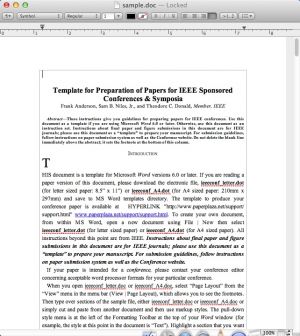 How To Prevent Children Accessing Unwanted Websites on Mac
How To Prevent Children Accessing Unwanted Websites on Mac
Nowadays, almost every Internet user developed a habit of getting their daily information from various websites. Even though this proves to be very fast and convenient, as you can get all the latest news simply by sitting at your desk, instead of getting the newspaper or magazines, the content that can be found online is not always safe for everybody. It's true, you can find interesting stuff on the web, like tutorials, funny videos, music or movies, but you can also easily come across potentially harmful content. It may range from adult websites and other inappropriate movies (PG-13 or R-rated) to bomb making guides and other gruesome web pages. The possibilities are endless. So, if your children have access to your Mac, it is always a good idea to block these websites and there are several ways to do that.
Block access to websites using Mac OS X's Parental Control app
Mac OS X comes with a built-in app, called Parental Control. This tool will help you easily restrict access to unwanted websites with just a few clicks of a mouse and I will show you how to use it in the step-by-step guide below.
Before using the Parental Control app, you might want to make a separate account for your kids (if you don't have one already) as you probably don't want to block yourself from accessing certain web pages.
Step 1
Go to the System Preferences menu and click on the Parental Control icon. You can find it under the "System" group, as you can see in the image below.
System Preferences Window
Step 2
Click on the lock icon in the bottom-left corner of the app's interface and enter your password so to start making modifications.
Step 3
After selecting the desired user account you want to restrict, click on the "Web" tab.
Parental Control app - Web tab
Step 4
Check the "Try to limit adult websites automatically" button and click on "Customize" so that you can manually add the web pages you want to block. The blocking process is pretty intuitive. All you have to do is click on the "+" button and provide the address of the website you want to block.
Customize website list
Step 5
Once you have finished listing the websites you want to be blocked, click on the "OK" button to close the pop-up window and then click on the lock to prevent any modifications from being made without your consent (your kids may try to modify the blacklist, but they won't be able to do it without knowing your password).
As you can see, the Parental Control app provides you with an easy way to block access to any unwanted websites. However, there are also several alternative methods.
Block websites using the Terminal
Another way of restricting access to adult and other unwanted web pages is using your Mac's Terminal. To launch it, simply go to your Utilities folder and click on the "Terminal" icon.
Once you have launched the Terminal, you need to type in the following command in order to open the hosts file for editing:
sudo nano /private/etc/hosts or simply sudo nano /etc/hosts
Sudo Command
Now the hosts file is opened and ready to be edited. In order to block the access to any desired website, all you have to do is enter "127.0.0.1" after the last text line, followed by the desired webpage. For example, if you want to block Facebook, the line will look like this:
127.0.0.1 www.facebook.com
Edit hosts file
After you finish adding all the desired websites you want to block, save the hosts file (control key + O) and close it (control key + X). Since you already have the Terminal opened, you might also want to clear your cache (because the changes might not apply otherwise) by entering the following command:
sudo dscacheutil -flushcache
Now you can easily test if the changes came into effect by opening your web browser and trying to access the blocked websites.
Block websites using third-party apps
Besides using the Parental Control app and modifying your Mac's hosts file, you can also install third-party software to block the access to unwanted websites. One of the most popular free applications is Self Control. It is very easy to use as all you have to do is simply launch the program and click on the "Edit blacklist" button to enlist the desired web pages and block them for a specific period of time.
Self Control
Self Control is not the only app that can help you block access to unwanted websites. You can also make use of several browser extensions or add-ons, as there are plenty of them for all major browsers. Extensions like BlockSite for Firefox and StayFocusd or Nanny for Google Chrome will provide you with a fast and simple way of restricting access to specific web pages.
Block websites through the router
You can also block the access to websites through your router. The exact steps are a bit different, depending of your router's model, but the idea is the same. Access your router's interface (by entering its address to your web browser, like 192.168.1.1, 192.168.0.1 or 192.168.2.1, for example), enter your username and password, go to the security panel and find the tab for the blocking controls - it should be something like "Content Filter" or "Access Restrictions". Once you are there, simply add the websites your want to block and that's it.
Conclusion
As you can see, there are lots of ways to restrict access to unwanted web pages on Mac. Choose the one that fits you best and make sure the changes took effect with your default web browser.





Comments
Subscribe to comments